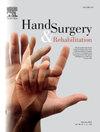在手腕部手术后2年影响调查应答率的术前因素:一项回顾性研究。
IF 1
4区 医学
Q4 ORTHOPEDICS
引用次数: 0
摘要
背景:随着患者报告的预后(PRO)变得越来越有价值,确定与PRO调查无反应相关的因素是很重要的。本研究的目的是探讨在手腕部手术后两年内与调查反应率相关的术前因素。方法:在手术登记处登记的患者在基线和在手腕部手术后两年进行电子调查。调查问卷包括人口统计学、6个患者报告结果信息系统(PROMIS)域、数字疼痛量表(NPS)、简明密歇根手部问卷(BMHQ)和肌肉骨骼结果数据评估和管理系统(modem)期望域。对2年调查有反应的患者与没有完成任何2年调查的患者进行比较。结果:361例患者完成了基线调查,253例患者(70%)完成了术后2年的调查。调查无应答与年龄较小、受教育程度较低、未婚、收入较低、吸烟、饮酒、手术前受伤、较差的允诺社会满意度、较差的允诺疼痛干扰、较差的允诺焦虑、较差的NPS关节评分、较差的BMHQ评分和较低的治疗期望相关。多变量logistic回归分析证实,年龄较大、基线BMHQ评分较高、治疗预期较高和每月饮酒1-4次是调查反应率增加的独立预测因素。结论:本研究确定了多种社会人口统计学和患者报告的因素与在手腕部手术后两年的调查无反应相关。这些发现可以指导有针对性的策略,以提高手部和手腕手术后的长期调查反应率。本文章由计算机程序翻译,如有差异,请以英文原文为准。
Preoperative factors that impact survey response rate two years after hand and wrist surgery: A retrospective study
Background
As patient-reported outcomes (PROs) become increasingly valuable, it is important to identify factors related to PRO survey nonresponse. The purpose of this study was to investigate preoperative factors associated with survey response rates two years after hand and wrist surgery.
Methods
Patients enrolled in a surgical registry were administered an electronic survey at baseline and two years after hand and wrist surgery. Questionnaires included demographics, six Patient-Reported Outcomes Information System (PROMIS) domains, Numeric Pain Scales (NPS), Brief Michigan Hand Questionnaire (BMHQ), and Musculoskeletal Outcomes Data Evaluation and Management System (MODEMS) expectations domain. Patients who responded to the 2-year survey were compared to the patients who did not complete any of the 2-year survey.
Results
There were 361 patients who completed the baseline survey and 253 patients (70%) completed the 2-year postoperative survey. Survey nonresponse was associated with younger age, less education, being unmarried, lower income, smoking, alcohol use, injury prior to surgery, worse PROMIS Social Satisfaction, worse PROMIS Pain Interference, worse PROMIS Anxiety, worse NPS joint score, worse BMHQ score, and lower treatment expectations. Multivariable logistic regression analysis confirmed that older age, better baseline BMHQ scores, greater treatment expectations and drinking alcohol 1–4 times per month were independent predictors of increased survey response rate.
Conclusion
This study identified multiple socio-demographic and patient-reported factors related to survey nonresponse two years after hand and wrist surgery. These findings may guide targeted strategies to improve long-term survey response rates following hand and wrist surgery.
求助全文
通过发布文献求助,成功后即可免费获取论文全文。
去求助
来源期刊

Hand Surgery & Rehabilitation
Medicine-Surgery
CiteScore
1.70
自引率
27.30%
发文量
0
审稿时长
49 days
期刊介绍:
As the official publication of the French, Belgian and Swiss Societies for Surgery of the Hand, as well as of the French Society of Rehabilitation of the Hand & Upper Limb, ''Hand Surgery and Rehabilitation'' - formerly named "Chirurgie de la Main" - publishes original articles, literature reviews, technical notes, and clinical cases. It is indexed in the main international databases (including Medline). Initially a platform for French-speaking hand surgeons, the journal will now publish its articles in English to disseminate its author''s scientific findings more widely. The journal also includes a biannual supplement in French, the monograph of the French Society for Surgery of the Hand, where comprehensive reviews in the fields of hand, peripheral nerve and upper limb surgery are presented.
Organe officiel de la Société française de chirurgie de la main, de la Société française de Rééducation de la main (SFRM-GEMMSOR), de la Société suisse de chirurgie de la main et du Belgian Hand Group, indexée dans les grandes bases de données internationales (Medline, Embase, Pascal, Scopus), Hand Surgery and Rehabilitation - anciennement titrée Chirurgie de la main - publie des articles originaux, des revues de la littérature, des notes techniques, des cas clinique. Initialement plateforme d''expression francophone de la spécialité, la revue s''oriente désormais vers l''anglais pour devenir une référence scientifique et de formation de la spécialité en France et en Europe. Avec 6 publications en anglais par an, la revue comprend également un supplément biannuel, la monographie du GEM, où sont présentées en français, des mises au point complètes dans les domaines de la chirurgie de la main, des nerfs périphériques et du membre supérieur.
 求助内容:
求助内容: 应助结果提醒方式:
应助结果提醒方式:


